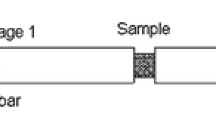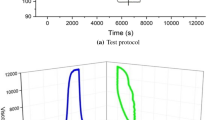Abstract
The aim of this work is to evaluate the effect of several types of plasticizers on the glass–rubber transition temperatures (T g) of polyester-based polyurethane binders, using dynamic mechanical analysis (DMA). The polyester polyol commercially named Desmophen® 2200 (D2200®) has been investigated for use as binder for composite propellant applications due to its good ballistic properties and also due to its potential glass–rubber transition temperature when mixed with polar energetic plasticizers. Therefore, it is important to evaluate the behavior of D2200® with different energetic plasticizers. In the present work, this inert polar binder was mixed individually with several different plasticizers and cured with a polyisocyanate commercially named Desmodur® N3400. The plasticizers used were: nitrate ester methyl trimethylol ethane trinitrate (TMETN), N-(n-butyl)-N-(2-nitroxyethyl) nitramine (Bu-NENA), bis-(2,2-dinitropropyl) formal and bis-(2,2-dinitropropyl) acetal mix 1:1 (BDNPF-A), nearly monodispersed low molar mass azido-terminated glycidyl azide polymer (GAP-A), ethylene glycol bis-(azidoacetate) (EGBAA) and 1,2-bis-(2-azidoethoxy) ethane (TEGDA) or BATEG, bis-azido-triethylene glycol, in an amount of 35 mass/%. The cured elastomers were characterized using torsion DMA at several frequencies, and the loss factor curves were described with exponentially modified Gaussian (EMG) distribution functions. Increasing deformation frequency in DMA increases T g, and an apparent activation energy was correlated with plasticizer performance. The plasticizer ability to decrease T g follows the order: TEGDA > butyl-NENA > GAP-A > EGBAA > BDNPF-A > TMETN. The ability of each energetic plasticizer could be related to its molecular structure, as well as to its molar mass and interaction possibilities with the polymer chains.





Similar content being viewed by others
References
Cerri S, Bohn MA, Menke K, Galfetti L. Aging of ADN rocket propellant formulations with desmophen®-based elastomer binder. Propellants Explos Pyrotech. 2014;39:526–37.
Bohn MA. Impacts on the loss factor curve and quantification of molecular rearrangement regions from it in elastomer bonded energetic formulations. In: Armstrong RW, Short JM, Kavetsky RA, Anand DK, Coord. editors. Energetics science and technology in central europe. USA: Center for Energetic Concepts Development Series, University of Maryland; 2012. p. 195.
Provatas A. Energetic polymers and plasticisers for explosive formulations: a review of recent advances. Australia: DSTO—Aeronautical and Maritime Research Laboratory; 2000. p. 42p.
Ek S, Eldsäter C, Goede P, Holmgren E, Tryman R, Latypov N, Raymond YGY, Wang LY. Synthesis and characterisation of 2,2-dinitro-1,3-propanediol-based plasticisers. Cent Eur J Energ Mater. 2005;2(4):33–45.
Mousaviazar A, Keshavarz MH, Hayaty M, et al. Synthesis, characterization and thermal behavior of 2,4-dinitrophenoxy ethanol as a suitable plasticizer for propellants formulations. J Therm Anal Calorim. 2016;126(2):681–88.
Cerri S, Bohn MA, Menke K, Galfetti L. Characterization of ADN/GAP-Based and ADN/Desmophen®-Based Propellant Formulations and Comparisons with AP Analogues. Propellants Explos Pyrotech. 2014;39:192–204.
Fox TG, Flory PJ. Second-order transition temperatures and related properties of polystyrene. I. Influence of molecular weight. J Appl Phys. 1950;21:581–91.
Flory PJ. The configuration of real polymer chains. J Chem Phys. 1949;17:3.
Damse RS, Singh A. Evaluation of energetic plasticisers for solid gun propellant. Def Sci J. 2008;58(1):86–93.
Sperling LH. Introduction to physical polymer science. 4th ed. Hoboken, NJ: Wiley, Inc.; 2005.
Cadogan DF, Howick CJ. Plasticizers. Ullmann´s Encyclopedia of Industrial Chemistry, Weinheim: Wiley-VCH Verlag GmbH & Co. KGaA; 2012. Vol 27.
Wypych G. Handbook of plasticizers. 2nd ed. Toronto: ChemTec Publishing; 2012.
Lui G, Lee-Sullivan P, Thring RW. Determination of activation energy for glass transition of an epoxy adhesive using dynamic mechanical analysis. J Therm Anal Calorim. 2000;60:377–90.
Bihari BK, Wani VS, Rao NPN, Singh PP, Bhattacharya B. Determination of activation energy of relaxation events in composite solid propellants by dynamic mechanical analysis. Def Sci J. 2014;64(2):173–8.
Bohn MA. Modelling of loss factors of elastomer binders of high explosive charges and composite rocket propellants to separate binder fractions with different molecular mobility used to follow ageing. In: 18th International Seminar on New Trends in Research of Energetic Materials (NTREM), Pardubice, Czech Republic. April 15–17;2015.
Tsagaropoulos G, Eisenberg A. Dynamic mechanical study of the factors affecting the two glass transition behavior of filled polymer. Similarities and differences with random ionomers. Macromolecules. 1995;28:6067–77.
Zohari N, Abrishami F, Sheibani NJ. A novel simple correlation for predicting glass transition temperature of energetic azido-ester plasticizers through molecular structures. J Therm Anal Calorim. 2016. doi:10.1007/s10973-016-5738-6.
Boyer RF. Dependence of mechanical properties on molecular motion in polymers. Polym Eng Sci. 1968;8(3):161–85.
Azoug A, Nevière R, Constantinescu A. Molecular origin of the influence of the temperature on the loss factor of solid propellant. Propellants Explos Pyrotech. 2015;40:469–78.
Author information
Authors and Affiliations
Corresponding author
Rights and permissions
About this article
Cite this article
Lemos, M.F., Bohn, M.A. DMA of polyester-based polyurethane elastomers for composite rocket propellants containing different energetic plasticizers. J Therm Anal Calorim 131, 595–600 (2018). https://doi.org/10.1007/s10973-016-5945-1
Received:
Accepted:
Published:
Issue Date:
DOI: https://doi.org/10.1007/s10973-016-5945-1




